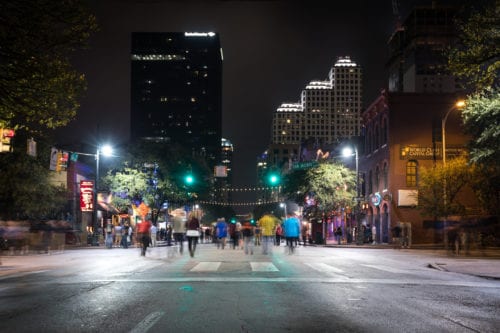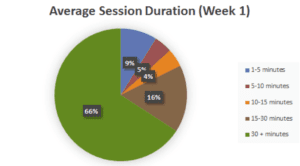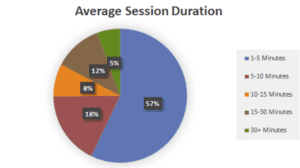Downtown Austin at Night on Sixth Avenue, Texas, USA. People are walking while the street is closed for cars at night.

How a Loading Zone Can Facilitate Personal Mobility Services and Promote Safety
In spring of 2018, Rocky Mountain Institute (RMI) and the Austin Transportation Department (ATD) conducted a “curb access” pilot aimed at improving the safety and user experience of accessing new mobility services. The pilot took place at the corner of West 6th Street and Nueces Street, at the edge of one of Austin’s most popular entertainment districts. For 45 days, we repurposed four metered parking spaces into one contiguous loading zone in front of Little Woodrow’s, a popular daytime and nighttime destination. Users of the loading zone were given five minutes to pick up and drop off their passengers. The zone was available for a wide range of curb uses (including commercial and personal vehicles). However, our primary interest was to understand the role a loading zone could play in facilitating greater use of mobility services—in this case ride-hailing services like Lyft, Uber, and RideAustin—and therefore to facilitate a shift away from personal vehicle use. We were particularly interested in understanding whether the loading zone could enhance the mobility service user experience, including improving safety, and ultimately found that it does. Although the sample size was rather small, video footage showed safer vehicle boardings and exits at the designated curbside pick-up and drop-off site, compared to dropping passengers off in the middle of a travel lane.
Reversing the Trend of Auto-Centric Urban Design
In July of 2017, RMI received a grant from the Robert Wood Johnson Foundation to explore and enhance the relationships among health, urban design, and personal mobility. This grant helped advance our Mobility Transformation Program in Austin, and it opened up an opportunity to work on an entirely new challenge. While RMI has always been conscious of the health benefits of a zero-carbon energy system, this opportunity has enabled us to think on a deeper level about tangible strategies for improving public health.
Personal mobility is one of the largest contributors to greenhouse gas emissions in Austin—and the world. It also plays an undeniable role in impacting, both positively and negatively, our physical and mental health, particularly when considering its influence on our built environment. In the US, we’ve largely designed our cities and streets around single-occupancy, personally owned automobiles. In doing so, we’ve divided communities, decreased physical activity, reduced pedestrian safety, and dramatically increased carbon emissions.
At RMI, we’ve been exploring the ways in which emerging mobility services and business models can help reverse the trend of auto-centric urban design practices that have dominated city building for nearly a century. Ride-hailing services have shown great promise in providing an attractive alternative to personally owned vehicles and, ultimately, helping free up billions of square feet of valuable urban space previously allocated to parking. But as these services grow, they present new challenges for how people safely access mobility and reach the destinations they seek.
Safety as a Health Metric
Pedestrian safety has become an increasing concern across the US, with injuries and deaths on the rise. More than 6,000 American pedestrians were killed in collisions with cars in 2017. Streets in America have become dangerous places to walk.
In proximity to our test environment in Austin, data shows that from January 2015 to May 2018, there were 18 reported crashes. Six of those crashes happened at or near the intersection of West 6th Street and Nueces Street, where the passenger zone would eventually be located and where many users of ride-hailing services are often loading in the middle of the street. And of course those are only the reported crashes.
Approach, Methods, and Results
A Data-Driven Approach: RMI and ATD worked together to develop a data-driven strategy that included on-the-ground surveys, sensors at the site, and a camera to observe activity around the loading zone.
Pre-Demonstration Survey Method and Results: RMI and ATD staff conducted 112 in-person surveys along West 6th Street to determine how people travel to the area and whether a passenger loading zone was viewed as useful.
- 27 percent of respondents drove themselves to the area; 21 percent took a ride-hailing service or taxi
- Twice as many people said a loading zone would increase their satisfaction with pick-ups/drop-offs in the area as said it would not
End-of-Demonstration Survey Method and Results: RMI and ATD conducted 41 in-person, end-of-demonstration surveys June 8–14, 2018.
- 26 percent of respondents had used the passenger zone
- Of those, 28 percent arrived by TNC and 28 percent by personal vehicle
- All respondents believed that passenger zones can improve safety and convenience
- When asked where else in the city passenger zones would be helpful, respondents offered downtown, the Domain, other areas on 6th Street, and various entertainment venues in Austin—such as stadiums, clubs, and bars
Sensor Data Collection Method and Results: RMI and ATD partnered with Municipal Parking Services to install four sensors at the loading zone five days prior to the start of the demonstration. These sensors recorded “curb sessions” each time one or more vehicles entered the loading zone. During those five days, vehicles continued to pay and park in the four spaces. In Weeks 2 through 7 the loading zone was in effect. Data collected is shown in the table below.
Curb Sessions (Before and During Pilot)
* Week 1 served as a prepilot baseline, with metered parking still available
It is important to note that the number of sessions during any given week of the demonstration did not surpass the number of sessions observed during Week 1 (n=91), when the spaces were still being used for parking. We address some probable reasons for this outcome below.
Session Duration
Changing the designation of the four parking spaces from metered parking to a loading zone had the expected effect of shifting the majority of curb sessions from long (30+ minutes) to very short (less than five minutes).
During Week 1, when the zone was still being used for metered parking, most curb sessions were greater than 30 minutes.
Upon designation of the loading zone, most sessions were less than 5 minutes.
Camera Observations
To complement the sensor-based data, RMI installed a camera across the street from the loading zone to validate the detection rates being reported by the Municipal Parking Services sensors and provide a number of observations related to pedestrian movements, the nature of passenger loading and unloading (both at the curb and in the street), and the safety impact of improvements made by the demonstration.
Evening and nighttime (i.e., after 5 p.m.) footage shows that the majority of curb use was for ride-hail. We also observed a clear contrast in the safety of loading and unloading practices at the loading zone versus on the opposite side of the street, where there was no loading zone. During the peak evening hours of Thursday, Friday, and Saturday, as many as three ride-hail vehicles can be observed picking up or dropping off passengers at the curb in the loading zone simultaneously, while passengers on the opposite side can be observed running or walking to and from the middle of the street, navigating a chaotic environment of moving cars, so that they could be picked up or dropped off.
Lessons Learned
RMI and ATD captured several insights that, if employed in future efforts, would improve the success of loading zones in enhancing the safe adoption of ride-hail and other mobility services.
User Awareness: A more extensive public information campaign and enhanced wayfinding could contribute to higher intended loading zone usage in future deployments. Seventy-six percent of respondents to the end-of-demonstration survey reported not being aware of the passenger zone’s existence. For the demonstration, the city also covered the pay station near the zone, so that individuals would not attempt to pay for parking. This may have given the appearance that the entire zone was off limits. The visibility of loading zone signage was limited at night as well. RMI and ATD considered incorporating a lighting feature to direct drivers and passengers to the zone, but concerns about distracting drivers ultimately prevented it. In addition, although ride-hailing services and taxi companies were contacted about the pilot program, it is uncertain how many drivers were aware of the passenger loading zone pilot and its location.
Location: To direct users to the loading zone, we partnered with Lyft to geocode a pin within its app. This certainly improved the convenience of accessing the loading zone for a significant number of people. However, as a safety measure, only the users who were on the same side of the street as the loading zone were notified of its existence and directed to it through the ride-hailing app. This precaution was meant to reduce the likelihood of jaywalking. By placing loading zones on both sides of the street, we would have captured more users.
Time-of-Day: Daytime camera footage shows that commercial uses (e.g., food and beer deliveries) and restaurant staff parking constituted the primary uses of the loading zone. Technically this is a misuse of the loading zone. Daytime enforcement can help ensure loading zones are used as intended. But enforcement of loading zones is a technical and staffing challenge for most cities. At the same time, we observed that, consistent with national trends, demand for ride-hail services was greatest during evening hours. “Evening loading zones”—metered parking spaces designated as loading zones only during evening hours—may facilitate greater usage while maintaining a significant portion of the city’s parking revenue.
The Bottom Line
Redesigning metered spaces as loading zones is not a quick and easy process for cities. Public engagement, staffing, project management, striping, signage, and loss of parking revenue all contribute to what is a very complex process. However, if those pieces are in place, a city may be able to facilitate greater and safer usage of mobility services, and enhance overall user experience associated with them. Over time, this can help give citizens the assurance they need to shift from personally owned vehicles to mobility service alternatives.
This pilot was an illuminating opportunity to understand the complexities of curb management. Many unanswered questions remain regarding the optimal timing, location, and communication of innovative curb uses. Going forward, RMI is eager to share lessons learned and collaborate with cities and organizations around the globe, to begin to tackle this challenge in a way that will give rise to a clean, efficient, and affordable mobility system.

